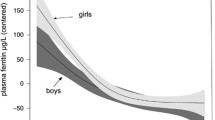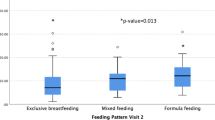Abstract
Background: Iron-deficiency anemia during pregnancy is still common in developed countries. The aim of this study was to evaluate the influence of maternal anemia on the infant’s iron status at 9 months of age in Moncton, NB.
Methods: Mothers giving birth between April 1998 and February 1999 were selected from medical records. A letter was sent to invite them to participate. In total, 75 mothers with their infants were examined.
Results: The proportion of iron-deficiency anemia was higher (p = 0.055) in the group born to anemic compared to non-anemic mothers. A positive association between the mother’s haemoglobin and haematocrit during her 3rd trimester and her infant’s haemoglobin and haematocrit was found at 9 months of age. These results are not explained by differences in feeding practices and socio-economic status between groups.
Interpretation: Infants born to mildly anemic mothers may be at risk of developing anemia.
Résumé
L’anémie maternelle demeure fréquente dans les pays industrialisés. Le but de cette étude était d’évaluer l’influence de l’anémie maternelle sur le statut en fer des enfants âgés de neuf mois dans la région de Moncton au N-B. Les mères qui avaient accouchées entre avril 1998 et février 1999 furent sélectionnées à partir des dossiers médicaux. Une lettre leur était envoyée pour solliciter leur participation. Au total, 75 mères avec leur nourrissons furent étudiés. La proportion d’enfants avec une anémie ferriprive était plus élevée (P = 0,055) dans le groupe né de mères anémiques. Une association positive entre l’hémoglobine et l’hématocrite de la mère au 3e trimestre et l’hémoglobine et l’hématocrite du nourrisson fut notée. Ces résultats ne sont pas expliqués par des différences au niveau des habitudes alimentaires et du statut socio-économique entre les groupes. Les résultats suggèrent que les enfants nés de mères légèrement anémiques sont peuvent être à risque de développer une anémie.
École des sciences des aliments, de nutrition et d’études familiales, Université de Moncton, Moncton, Nouveau-Brunswick
Similar content being viewed by others
References
Gaspar MJ, Ortega RM, Moreiras O. Relationship between iron status in pregnant women and their newborn babies. Acta Obstet Gynecal Scand 1993;72:534–37.
Allen LH. Pregnancy and iron deficiency: Unresolved issues. Nutr Rev 1997;55(4):91–101.
Lozoff B, Jimenez E, Wolf AW. Long-term developmental outcome of infants with iron deficiency. N Engl J Med 1991;325:687–94.
Walter T, de Andraca I, Chadud P, Perales CG. Iron deficiency anemia: Adverse effects on infant psychomotor development. Paediatrics 1989;84:7–17.
de Andraca I, Castillo M, Walter T. Psychomotor development and behavior in iron-deficient anemic infants. Nutr Rev 1997;55:125–32.
Kwik-Urbe CL, Golubt MS, Keen CL. Behavioral consequences of marginal iron deficiency during development in a murine model. Neurotoxicol Teratol 1999;21:661–72.
Feightner JW. Prevention of iron deficiency anemia in infants. In: Canadian Task Force on the Periodic Health Examination. Canadian Guide to Clinical Preventive Health Care. Ottawa: Health Canada, 1994;244–55.
Société Canadienne de pédiatrie, les diététistes du Canada et Santé Canada. Nutrition du nourrisson en santé né à terme. Ministre de travaux publics et Services gouvernementaux du Canada, Ottawa 1998.
Singla PN, Tyagi M, Kumar A, Dash D, Shankar R. Fetal growth in maternal anemia. J Trop Pediatr 1997;43:89–92.
Hokama T, Takenaka S, Hirayama K, Yara A, Yoshida K, Itokazu K, et al. Iron status of new-borns born to iron deficient anemic mothers. J Trop Pediatr 1996;42:75–77.
Bhargava M, Iyer PU, Kumar R, Ramji A, Kapani V, Bhargava K. Relationship of maternal serum ferritin with foetal serum ferritin, birth weight and gestation. J Trop Pediatr 1991;37:149–52.
Choi JW, Kim CS, Pai, SH. Erythropoietic activity and soluble transferring receptor level in neonates and maternal blood. Acta Paediatr 2000;89:675–79.
Colomer J, Colomer C, Gutierrez D, Jubert A, Nolasco A, Donat J, et al. Anaemia during pregnancy as a risk factor for infant iron deficiency: Report from the Valencia Infant Anaemia Cohort (VIAC) Study. Paediatr Perinat Epidemiol 1990;4:196–204.
Kilbride J, Baker TG, Parapia LA, Khoury SA, Shuqaidef SW, Jerwood D. Anaemia during pregnancy as a risk factor for iron-deficiency anaemia in infancy: A case-control study in Jordan. Int J Epidemiol 1999;28:461–68.
Piwoz EG, Creed de Kanashiro H, Lopez de Romana G, Black RE, Brown KH. Potential for misclassification of infants’ usual feeding practices using 24-hour dietary assessment methods. J Nutr 1995;125(1);57–65.
Rioux MF, Michaud J. Anémie maternelle dans les régions du sud-est et nord-est du Nouveau-Brunswick et impact sur les paramètres hématologiques et la croissance du nouveau-né. Can J Diet Prac Res 2001;62:70–75.
Turgeon-O’Brien H, Santure M, Maziade J. The association of low and high ferritin levels and anemia with pregnancy outcome. Can J Diet Prac Res 2000;61(3):121–27.
Laverdière S, Turgeon-O’Brien H. État nutri-tionnel en fer d’un groupe d’enfants âgés de 12 à 20 mois de la région de Charlevoix du Québec. Med Nut 1997;5:181–89.
Lehmann F, Gray-Donald K, Mongeon M, Di Tommaso S. Iron deficiency anemia in 1-year-old children of disadvantaged families in Montreal. CMAJ 1992;146(9):1571–77.
Innis SM, Nelson CM, Wadsworth LD, MacLaren IA, Lwanga D. Incidence of iron-deficiency anaemia and depleted iron stores among nine-month-old infants in Vancouver, Canada. Can J Public Health 1997;88(2): 80–84.
Sherriff A, Emond A, Bell JC, Golding J and ALSPAC study team. Should infants be screened for anaemia? A prospective study investigating the relation between haemoglobin at 8, 12, and 18 months and development at 18 months. Arch Dis Child 2001;84:480–85.
Author information
Authors and Affiliations
Corresponding author
Rights and permissions
About this article
Cite this article
Savoie, N., Rioux, F.M. Impact of Maternal Anemia on the Infant’s Iron Status at 9 Months of Age. Can J Public Health 93, 203–207 (2002). https://doi.org/10.1007/BF03405001
Received:
Accepted:
Published:
Issue Date:
DOI: https://doi.org/10.1007/BF03405001




